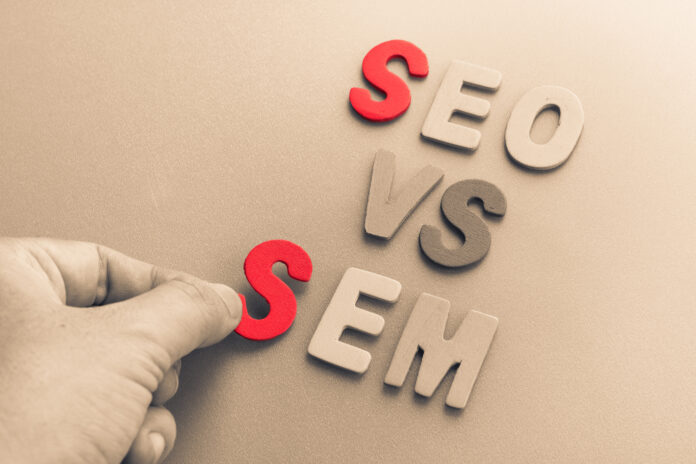If you’ve ever wondered whether to focus on SEO or SEM, you’re not alone. These two strategies often spark debate among businesses looking to boost their online presence. But the answer isn’t about choosing one over the other—it’s about understanding their strengths and how they fit into your unique goals.
Both are effective tools for driving traffic and growing your business, but they serve different purposes and deliver results in distinct ways. Let’s explore what makes each strategy shine, highlight examples of success, and identify which businesses benefit most from SEM’s immediate impact or SEO’s long-term value.
What is SEO?
SEO (Search Engine Optimization) is the process of optimizing your website to rank higher in organic (non-paid) search results. It focuses on improving your site’s content, structure, and authority through techniques like:
- Keyword Optimization: Using relevant terms that match user searches.
- Backlink Building: Earning links from reputable sites to boost credibility.
- Technical Improvements: Enhancing site speed, mobile friendliness, and overall usability.
SEO is often described as a long-term investment, delivering sustainable traffic over time as your site gains authority.
Real-World Example: SEO Success
A local bakery wanted to increase foot traffic and online orders. By creating optimized blog posts about “Best Birthday Cakes in Brantford” and “How to Host a Dessert Table,” and earning backlinks from local food bloggers, the bakery’s website rose to the top of organic search results. Over six months, organic website visits increased by 45%, with a notable spike in inquiries and in-store sales.
Pros of SEO:
- Long-Term Value: Generates consistent traffic without recurring ad costs once established.
- Credibility: Organic results are trusted more by users than paid ads.
- Cost-Effective Over Time: Maintenance is less expensive after initial investments.
Cons of SEO:
- Time-Intensive: Results can take months or even years to materialize.
- Algorithm Sensitivity: Search engine updates may affect rankings, requiring ongoing adjustments.
What is SEM?
SEM (Search Engine Marketing) focuses on paid ads that appear in search engine results, often at the top of the page. By bidding on keywords through platforms like Google Ads, businesses can reach their ideal audience almost instantly. SEM operates on a pay-per-click (PPC) model, meaning you pay only when someone clicks your ad.
Real-World Example: SEM Success
A plumbing company launched a Google Ads campaign targeting “emergency plumbing services” in their local area. Within 24 hours, their ads started showing at the top of search results. Over a month, the campaign generated 50 calls, resulting in 20 booked jobs worth over $10,000 in revenue—a return far exceeding their ad spend.
Pros of SEM:
- Instant Results: Ads go live immediately, driving traffic right away.
- Precise Targeting: Target specific keywords, locations, and demographics for maximum relevance.
- Measurable & Flexible: Real-time performance data allows for quick adjustments.
- Scalable: Campaigns can be ramped up or down depending on your budget and needs.
Cons of SEM:
- Ongoing Costs: Traffic stops as soon as you stop paying.
- Competitive Pricing: Popular keywords can be expensive in highly competitive industries.
SEO and SEM in Action: Real-World Examples
These strategies shine in different scenarios:
- SEO: Ideal for businesses with patience to build long-term credibility, like a content-driven blog or local boutique aiming for consistent organic visibility.
- SEM: Perfect for time-sensitive campaigns, like promoting a flash sale or reaching customers searching for urgent services.
Combining Both for Maximum Impact
For many businesses, the ideal approach is to combine SEO and SEM. Here’s why:
- Start with SEM: Launch paid ads to drive immediate traffic and test high-performing keywords.
- Build SEO Over Time: Use the insights gained from SEM to develop content and optimize your site for long-term visibility.
For example, a local boutique might start with an SEM campaign to promote their grand opening, capturing immediate attention in the area. Meanwhile, they can invest in SEO by building a blog with keywords like “unique fashion in [city],” ensuring lasting visibility.
Why SEM Often Outshines SEO in the Short Term
While SEO is excellent for long-term growth, SEM’s ability to deliver instant, targeted results gives it an advantage for businesses looking to generate leads and revenue right away. For example, a local retailer running a weekend sale can’t wait months for SEO to kick in; SEM ensures their ads appear in front of shoppers searching for “local deals” today.
Let’s Get Started
At Vista Reach, we specialize in crafting SEM strategies that deliver measurable results while helping businesses plan for future growth with SEO. Whether you’re looking to boost your online visibility, generate leads, or create a balanced strategy, we’re here to help.
Contact me today at gmccreary@vistaradio.ca or 226-583-0594 to schedule a consultation. Let’s discuss how SEO, SEM, or a combination of both can deliver the results your business needs—fast!

